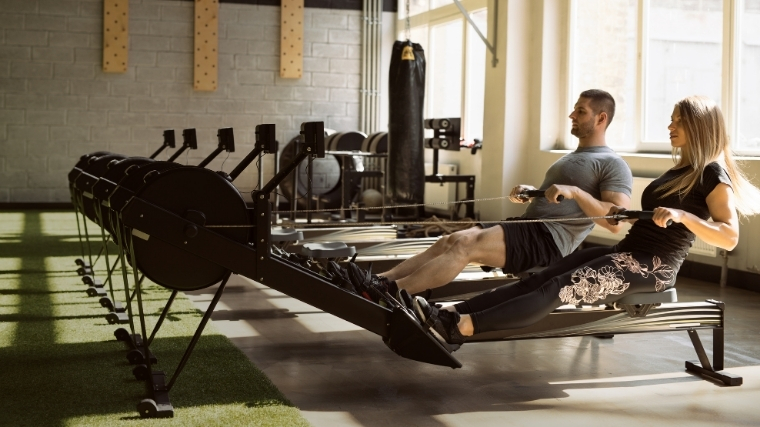You probably learned about “PEMDAS” in school as a mnemonic device for completing an arithmetic problem. If math wasn’t your favorite subject, fret not — you don’t need to be a wizard to work out how to properly move through a workout.
However, haphazardly throwing exercises into your gym routine may be doing you more harm than good in some cases. If you follow a pre-written plan, don’t think for a second that the exercise order is random.

Following a sequence properly can make or break your results. This is true in the classroom, it’s true in the kitchen, and it’s absolutely true in the gym. Here’s how exercise order affects your results — and how to get it right from the jump.
How to Properly Order Exercises
Principles of Exercise Sequencing
Ordering your exercises isn’t as simple as following a protein-packed cooking recipe, but it also isn’t as complicated as calculus.
You can tweak your own workouts so they flow smoothly by adhering to a few fundamental principles. Note that these guidelines are little more than general advice for sound workout design — they aren’t hard rules you need to adhere to in order to make progress.
Practice Technique First
If you’re working on your technique in a specific movement or for a specific sport, that stuff should take priority in your session.
Trying to sharpen a motor skill after you’ve been grinding away in the gym for an hour may not be wise. Fatigue affects everything from your balance to your breathing.
This idea is relevant for Olympic lifters learning to snatch, yogis practicing a particularly aggressive pose, or athletes working on their agility. If it’s technically demanding, get it done early while you’re fresh.
Work Big to Small
If you hit the gym to lift weights, you’ll generally want to start with the “meat and potatoes” movements first. These are your compound, multi-joint cornerstone lifts — squats, deadlifts, pull-ups, and the like.

“Large” exercises require a lot of energy, take a lot of stability and control to execute well, and have the highest loading potential. All of which you’ll have an easier time with if you perform them early on in your workout instead of at the end.
This idea is also supported by scientific research, which has demonstrated that people are generally strongest at the start of their session, so it’s appropriate to tackle the heaviest lifts early on. (1)
Compounds Before Isolation
There are two primary categories for resistance training exercises — compound movements that involve more than one joint, and isolation exercises that only involve one.
An isolation move like a curl is great for targeting your biceps. However, your biceps help you pull on the bar during a bent-over row. If you fatigue your arms first, your performance during rows may suffer.
There are caveats, but you’ll generally find more success by putting your smaller, single-joint isolation work after you hit your compounds.
Group by Equipment to Save Time
Finding the right tool for the job is a matter of trial and error, but it’s also necessary for making the best gains you can.
That said, if you’re strapped for time, you can shave minutes off your session by performing as many exercises as possible with the same equipment.
This can mean doing several dumbbell exercises back-to-back, or performing an entire workout at an adjustable cable station. This principle works especially well with calisthenics training, since you only need some open space and your body to work with.
Strength Training Before Cardio (Usually)
If you’re trying to build up multiple dimensions of fitness at the same time, take extra care about the order in which you train them.
Generally speaking, you should perform resistance training before cardiovascular exercise — even if cardio is of a higher priority to you.
This is due to the so-called “interference effect,” which states that the metabolic demand of endurance training can negatively impact your strength performance. However, the inverse isn’t true to the same degree, an idea backed by the scientific community. (2)(3)

That said, a short bout of low-intensity cardio is a great way to get your blood pumping during your warm-up.
Five to 10 minutes on the treadmill probably isn’t going to hamper the lifting that follows (it may even bolster it), so use your discretion here.
Exercise Order for Muscle Growth
If you’re after those sweet, sweet muscle gains in the weight room, how you design and perform is absolutely crucial. The order in which you perform your various movements can strongly impact how much mass you’ll ultimately pack on.
How It Works
To briefly pull back, remember that building muscle is as much a result of your diligence in the kitchen as it is in the gym. If you aren’t following a proper dietary plan and consuming enough calories, you aren’t likely to see the progress you’re looking for in the mirror.
When it comes to what you do under the lights in the weight room, however, exercise order matters. One of the main physiological principles of muscle hypertrophy — the biological process of repairing and regrowing muscle tissue — is muscular damage.

Clustering your exercises together to repeatedly hammer the target muscle group is the best way to ensure you’re causing adequate muscle damage.
This is especially true if you work more than one muscle per session, which most physique enthusiasts do. If you back off your biceps and let them rest too long, you may be leaving arm gains on the table.
What It Looks Like
To illustrate this idea visually, take a look at a generic bodybuilding-minded workout. The back-and-biceps pairing is a popular split for muscle growth, and for good reason.
On paper, you’ll notice that the back-focused movements are generally performed in succession, while the biceps exercises are either saved for after or are performed first thing:
Sample Workout
- Weighted Pull-Up: 3 x 8
- Dumbbell Row: 3 x 8
- Dumbbell Pullover: 2 x 12
- Seated Hammer Curl: 3 x 8
- EZ-Bar Reverse Curl: 2 x 12
This workout exemplifies a good starting point for exercise sequencing in bodybuilding. Movements are grouped in accordance with the primary muscles they involve, but are also clustered by the equipment you’ll use.
This would ensure that you fully tax every muscle in your back before moving on to focus on your biceps. It also guarantees that you aren’t scurrying back and forth across the gym floor, trying to find the right pair of dumbbells for every second or third exercise.
The middle three movements can all be done on the same exercise bench.
Exercise Order for Strength Gain
The pursuit of strength is a noble endeavor. It’s also extremely taxing and tests your patience as much as your body.
The most powerful strength athletes in the world measure their careers in years, not weeks. Individual workouts are but a drop in the (very large) bucket, but that isn’t an excuse to slack off about program design.
If anything, small adjustments to your exercise sequencing can amount to many pounds added to your barbell over time.
How It Works
If bodybuilding is all about compromising yourself to make things as difficult as possible for the purposes of growth, strength training focuses on the opposite.
You want to maximize your strength potential by ensuring adequate recovery on a set-to-set and lift-by-lift basis. As such, your exercise sequence should be set up to conserve as much energy and focus as possible.

Generally speaking, it’s wise to alternate between movements that work different muscle groups during a strength-based workout. This partially prevents the fatigue you accumulate on your first exercise from negatively impacting your performance on the lift that follows.
What It Looks Like
Strength programs come in a large, large variety of different flavors and functions. A powerlifter might balk at the concept of “leg day,” since many common powerlifting routines demand that you squat every time you’re in the gym in some fashion.
There’s a huge amount of wiggle room to this, but the general principle holds true. You’ll rarely see a strength-based workout for powerlifting, weightlifting, or strongman that asks you to hammer the same movement pattern twice or thrice in a row:
Sample Workout
- Box Squat: 3 x 5
- Good Morning: 2 x 8
- Board Press: 5 x 3
- Dumbbell Row: 3 x 8
- Back Extension: 2 x 15
This is a very general overview of what a strength-based workout might look like for an intermediate lifter who can tolerate a decent amount of volume in a single session.
The main takeaway here is that the athlete performing this workout avoids accumulating too much muscle-specific fatigue. Box squats and good mornings both work the lower body, but the former is considered a quad-dominant exercise while the latter torches the posterior chain.
The same idea holds true for the pressing and rows, albeit to a lesser degree. Performing heavy rows prior to your bench pressing might negatively impact your power output, since a strong and stable upper back is crucial for benching well at high intensities.
Exercise Order to Save Time
Having two or three hours every day to toil in the gym is an embarrassment of riches if you enjoy lifting weights.
That said, you don’t need your training to be a part-time job for it to be effective, and you definitely don’t need to plan your day around your workouts — though it may be necessary in some cases.

Saving time in the gym honestly depends a good deal on factors that you can influence before you even get there. Furnishing a home facility, packing your workout clothes in your car, or adding more bodyweight work will all cut down on the hours per week you spend accommodating your exercise routine.
To maximize your efficiency in the gym itself, group your movements by equipment used first and muscles worked second.
How It Works
Believe it or not, the majority of your time in the gym, particularly if you like to lift weights, isn’t actually spent training. Rest time between sets, moving to exercise stations, locating equipment, and other forms of “loose time” add up to a lion’s share of your total time investment.

Streamlining your gym logistics can cut down on the fluff without affecting the efficacy of the workout itself. To do this, work with the same piece of equipment for several movements in a row.
What It Looks Like
If you need to save time above all other factors, clump your barbell exercises together. Then, hit up the cable machine for as many movements as needed, and so on. That’s the gist of it, generally speaking.
This will contradict some of the principles behind exercise sequencing for muscle growth or strength gain, but it won’t entirely diminish the possibility of making gains in those areas.
For example, this is how you could sequence a full-body, free-weight-heavy routine. You’ll only need to hit up two locations for the entire thing:
Sample Workout
- Barbell Squat: 3 x 5
- Barbell Romanian Deadlift: 2 x 8
- Barbell Row: 3 x 8
- Dumbbell Bench Press: 3 x 8
- Dumbbell Row: 3 x 8
- Dumbbell Curl + Dumbbell Skull Crusher + Dumbbell Lateral Raise: 2 x 15 each.
Practically speaking, you should be able to complete all six exercises (including the tri-set cluster at the end), in under an hour. You could hit up this workout twice per week and guarantee that you’re working your entire body properly in roughly 90 minutes altogether.
You won’t spend time going back and forth between the dumbbell stands and the squat rack as you move through your session. In fact, you really only need to spend time changing out your weights.
Note, though, that clustering movements like this may only be feasible early on in your gym career. The fitter you become (no matter how you define it), the more specialized your training will need to be to continually challenge you, and the longer it will take.
Your Takeaways
The order in which you perform various exercises will affect your results. Exercise “sequencing” is a variable worth paying attention to no matter how you prefer to train, and it will change in accordance with your needs.
- Generally speaking, you’ll want to group exercises together that work the same muscle group if you’re trying to make those muscles grow.
- Strength training is more about training a movement rather than a muscle, so you should stagger your exercises accordingly.
- You can clump exercises that use the same type of equipment together if you really need to save time in the gym.
Remember that there is a tremendous amount of variability when it comes to exercise sequencing. Don’t adhere too rigidly to any on-paper advice; lean on practical experience and make adjustments that work for your needs.
Follow the Path
“I” comes before “e” — except for when it doesn’t. In the realm of health and fitness, no rule is absolute and no law is immutable. But that doesn’t mean you shouldn’t stick to your guns on things like proper exercise sequencing.
After all, you wouldn’t bake a cake by putting the flour in the oven. To get the results you’re after, you have to mix your effort in the proper order. If you don’t, the result may be both less tasty and less nutritious.
If you want to make fast, efficient progress, make sure your workout is designed to facilitate that. Get the order right, and the gains will flow.
References
1. Simão, R., de Salles, B. F., Figueiredo, T., Dias, I., & Willardson, J. M. (2012). Exercise order in resistance training. Sports medicine (Auckland, N.Z.), 42(3), 251–265.
2. Petré, H., Hemmingsson, E., Rosdahl, H., & Psilander, N. (2021). Development of Maximal Dynamic Strength During Concurrent Resistance and Endurance Training in Untrained, Moderately Trained, and Trained Individuals: A Systematic Review and Meta-analysis. Sports medicine (Auckland, N.Z.), 51(5), 991–1010.
3. Fyfe, J. J., Bishop, D. J., & Stepto, N. K. (2014). Interference between concurrent resistance and endurance exercise: molecular bases and the role of individual training variables. Sports medicine (Auckland, N.Z.), 44(6), 743–762.
Featured Image: Prostock-studio / Shutterstock